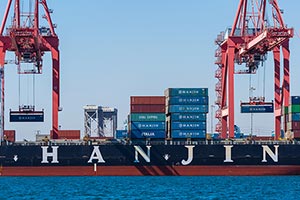Hanjin Bankruptcy Hurts Long Beach, But Doesn't Impact Other US Ports in September

The Hanjin Shipping Co. bankruptcy hit the Port of Long Beach hard, but spared most others from year-over-year losses in ocean container traffic, based on port statistics released for September.
Long Beach, the second-largest in California and the nation, reported a 16.6% drop in imports to 546,805 industry-standard 20-foot unit containers, or TEUs, down from 655,624 in September 2015. Port officials blamed the poor results on Hanjin canceling stops in Long Beach and the lack of Hanjin containers on other vessels in the pan-Asian CKYHE Alliance.
Other top ports in the United States weren’t impacted to the same magnitude because they weren’t as exposed to the bankruptcy.
Hanjin accounted for about 12% of the container volume in Long Beach but only about 4% at the Port of Los Angeles, according to port officials. This year, about 40% of Hanjin containers unloaded in the United States between Jan. 1 and Aug. 27 occurred in Long Beach, whereas 16% went to Los Angeles.
Topping out the list were ports at New York-New Jersey at 12%; Savannah, Georgia 6%; and Oakland, California 5%.
Hanjin steered many of its vessels to Long Beach rather than Los Angeles, in part, because it owns 54% of Total Terminals International, according to 2015 annual financial reports.
As a result, the Port of Los Angeles actually reported overall containers handled increased to 747,707 TEUs from 730,306 one year ago, or a 4.3% jump. Exports increased to 145,096 from 124,286, or a 16.7% increase. Imports increased 4.3% to 388,958. The amount of empty containers decreased 8.3% to 213,652.
“Despite challenges in global logistics due to the Hanjin bankruptcy, we’re pleased to see both import and export growth,” Port of L.A. Executive Director Gene Seroka said. “We continue to work diligently in collaboration with our many stakeholders to deliver on our customers’ supply chain requirements.”
Through September, overall cargo volumes in Los Angeles have increased 4.1% to 6.4 million TEUs, while in Long Beach they’ve dropped 4.6% to 5.1 million.
RELATED: Korean Court to Get Final Bids for Hanjin Assets by Early November
The Port of Oakland announced loaded import containers declined 4.2% to 70,307, but export containers rose 10% to 76,356 compared to September 2015. Year-over-year exports rose for the fifth time in the last six months.
“Exports make up more than 50 percent of our overall cargo volume,” said Port of Oakland's maritime director, John Driscoll. “So the continued growth in September shows we’re playing pretty well to our strength.”
Through September, total container traffic in Oakland, the seventh largest port, was 1,767,336 TEUs, a 3.5% increase from the year prior.
Ports in Seattle and Tacoma reported total imports were up 3% to 146,412 and total exports fell 10% to 119,918 year-over-year. After starting the year on a high note, exported containers dropped five out of the last seven months on a year-over-year basis, although a spokeswoman for the Northwest Seaport Alliance conceded that Hanjin also hurt September port traffic.
“Hanjin’s failure is the culmination of several years of poor commercial decisions and mismanagement, not just by Hanjin, but the industry as a whole. But it did not necessarily signal a major tipping point for the industry,” said Neil Dekker, director of container research at Drewry.
The global shipping consultants forecast that ocean container carriers would record a collective operating loss of $5 billion in 2016, but turn around and generate $2.5 billion in profits next year. Drewry projects higher ocean freight prices and more container traffic will also occur in 2017.
The Port of Virginia, which is sixth, said container traffic rose 2% last month, setting a new all-time September record at 219,857 TEUs, as compared 215,520 units a year ago.
“The peak-season cargo flow is steady — import TEUs were up 7% — and we are maintaining our consistency in delivery of service,” Virginia Port Authority CEO John Reinhart said in a statement. “Our productivity across the operation continues to trend in positive territory.”
The Georgia Ports Authority reported that total containers handled at the Port of Savannah dropped 2.9% to in September. Total traffic at the port, the fourth largest, has fallen seven out of the last nine months compared to the same period of 2015. Import containers increased 6.1% to 161,137, but export containers dropped 11% to 147,213. Through September, total containers handled for 2016 was 2,741,283, down 4.6% from the 2,872,109 handled in the first nine months of 2015. If the trend held, 2016 would be the first year the port saw a decline in traffic over the previous year since 2009.
The South Carolina Ports Authority said loaded import containers increased 5.1% to 74,009 TEUs and exports jumped 3.5% to 62,598. However, overall container traffic at the Port of Charleston fell 2.8% to 162,858 because of a 28% drop in empty containers coming into or going out of the port.
The trends are similar when examining 2016 overall at the ninth largest U.S. port. Loaded imports and exports are up 2%, but a empty containers dropped 15%. The result is a 1.5% decline in overall traffic to 1,487,101 compared to the same nine-month period in 2015.
Ports in New York-New Jersey and Houston are due to release results later in October.

